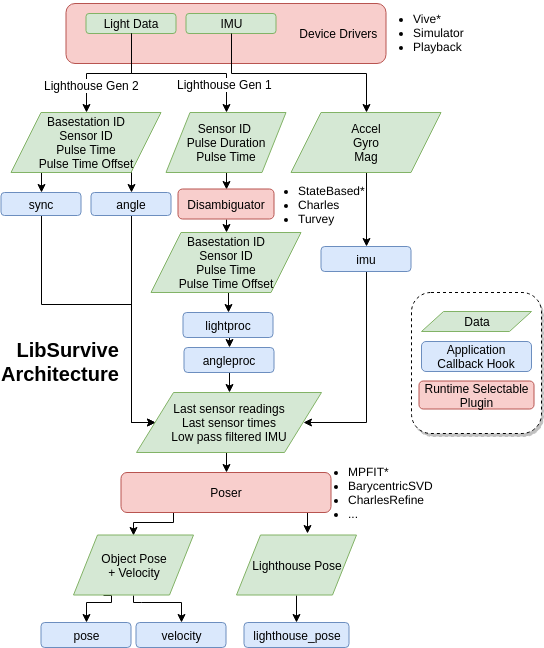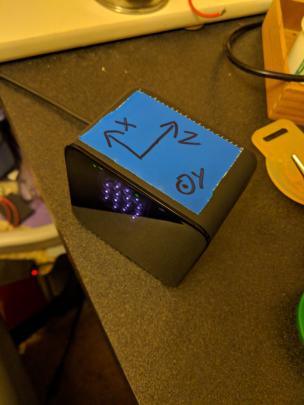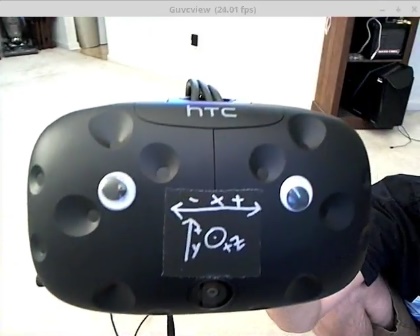An Open-Source tool for working with lighthouse-based tracking data, including support for the HTC Vive, which is still in the experimental phase.
Most of the development is discussed on Discord. Join the chat and discussion here: https://discordapp.com/invite/7QbCAGS
If you are an individual who bothers going back and watching some of these, PLEASE PLEASE PLEASE add a note to cntools#66 whenever something interesting happens. I want to make a highlight reel, but I don't want to sit through all the videos.
| Note | Youtube URL | Run time |
|---|---|---|
| First livestream | https://www.youtube.com/watch?v=sv_AVI9kHN4 | 5:01:25 |
| Second livestream | https://www.youtube.com/watch?v=gFyEbGQ88s4 | 4:03:26 |
| Summary of first and second livestream | https://www.youtube.com/watch?v=oHJkpNakswM | 23:00 |
| Third livestream | https://www.youtube.com/watch?v=RExji5EtSzE | 4:11:16 |
| Fourth livestream | https://www.youtube.com/watch?v=fces1O7kWGY | 4:50:33 |
| Fifth livestream | https://www.youtube.com/watch?v=hHt3twW5_fI | 3:13:38 |
| Sixth livestream | https://www.youtube.com/watch?v=JsfkNRFkFM4 | 3:44:49 |
| Seventh livestream | https://www.youtube.com/watch?v=EKSHvO3QSWY | 1:17:21 |
| Eighth livestream | https://www.youtube.com/watch?v=nSbEltdH9vM | 6:06:36 |
| Ninth livestream | https://www.youtube.com/watch?v=60sGTd8T-KY | 3:28:44 |
| Ninth B livestream | https://www.youtube.com/watch?v=IIYj1Ig_gz8 | 2:25:33 |
| May 2017 Summary | https://www.youtube.com/watch?v=dVXpHKktbzM | 5:58 |
| Tenth livestream | https://www.youtube.com/watch?v=8hqviGMlU7I | 3:30:46 |
Notes from second livestream trying to reverse engineer the watchman protocol: https://gist.github.com/cnlohr/581c433f36f4249f8bbc9c2b6450ef0e
Please see the issues for what help needs to be done now!
HackADay article and video with Dr. Yates on how they made the Vive a thing. http://hackaday.com/2016/12/21/alan-yates-why-valves-lighthouse-cant-work/
Excellent article written by Oliver Kreylos showing just how amazing the lighthouse system really is. Likely the best/most detailed review on the performance and accuracy of the lighthouse system. http://doc-ok.org/?p=1478
- WRT = With Respect To
- PoV / POV = Point of View (typically WRT to a LH, sometimes (though rarely) a sensor)
- LH = Lighthouse = Base Station = A device that produces a 1.8 MHz modulated sync pulse in IR and then sweeps the scene with laser planes.
- Sync Pulse = A pulse of modulated IR data sent from a ligthhouse, typically by the floodlight aspect of a lighthouse.
- Sweep Pulse = The evenlope created by a laser sweeping over a light sensor.
- OOTX = Omnidirectional Optical Transmitter = Data encoded in the sync pulses of the LHs.
- HMD = Headset = Main sensor receiver with a visual display for a human.
- WM = Watchman = Controller = The HTC Vive controller.
- TR = Tracker = Official HTC Tracker.
- LightcapElement = A single pulse of light, including a timestamp, source sensor and length of pulse.
- Disambiguator = System that accepts lightcap elements and pulls out OOTX data and relative sweep times of sweep pulses.
- Poser = Device to convert series of angles from a LH's PoV
There are two things you should consider doing to your system before running libsurvive.
(1) Install the udev rules: cp useful_files/81-vive.rules to /etc/udev/rules.d/ and reboot.
(2) If you are running on an NVIDIA Card, you will need to AllowHMD to true. Add the following line to your /etc/X11/xorg.conf device section: Option "AllowHMD" "yes"
High-performance HTC Vive Library
I say "high-performance" really this project is based tightly off of OSVR-Vive-Libre, but, specifically is an attempt to:
- Minimize external libraries. Actual reason for starting this: Downloading all of the libraries needed for OSVR-Vive-Libre maxed out my data plan.
- Put it under an open-source instead of a force-source license. (GPL to MIT/X11)
- Write it in C.
- Avoid extra layers where convenient.
- (long shot) Make the vive viable for use with Intel Integrated Graphics systems. [It works with HD4000 using DisplayPort. See "Intel Integrated Graphics" section below.]
Will I we succeed? Probably not. Definitely going to try! Though it's looking like we might.
- libUSB (Linux) or hidapi (Win, OSX; included in redist)
- pthread
- libX11 (Linux) or Native (win32) or OpenGL (OSX)
- zlib (Linux) or puff.c (win32, included in redist)
- Optionally OpenGL.
On Debian,
sudo apt-get install build-essential zlib1g-dev libx11-dev libusb-1.0-0-dev freeglut3-devshould be sufficient.
Temporarily needed packages: liblapack and libopenblas
On Debian, sudo apt-get install liblapacke-dev libopenblas-dev libatlas-base-dev
| Component Type | Component | Description | Authors |
|---|---|---|---|
| Poser | poser_charlesslow.c | A very slow, but exhaustive poser system. Calibration only. | @cnlohr |
| Poser | poser_daveortho.c | A very fast system using orthograpic view and affine transformations. Calibration only (for now) | @ultramn |
| Poser | poser_dummy.c | Template for posers | @cnlohr |
| Poser | poser_octavioradii.c | A potentially very fast poser that works by finding the best fit of the distances from the lighthouse to each sensor that matches the known distances between sensors, given the known angles of a lighthouse sweep. Incomplete- distances appear to be found correctly, but more work needed to turn this into a pose. | @mwturvey and @octavio2895 |
| Poser | poser_turveytori.c | A moderately fast, fairly high precision poser that works by determine the angle at the lighthouse between many sets of two sensors. Using the inscirbed angle theorom, each set defines a torus of possible locations of the lighthouse. Multiple sets define multiple tori, and this poser finds most likely location of the lighthouse using least-squares distance. Best suited for calibration, but is can be used for real-time tracking on a powerful system. | @mwturvey |
| Poser | poser_epnp.c | Reasonably fast and accurate calibration and tracker that uses the EPNP algorithm to solve the perspective and points problem. Suitable for fast tracking, but does best with >5-6 sensor readings. | @jdavidberger |
| Poser | poser_sba.c (default) | Reasonably fast and accurate calibration and tracker but is dependent on a 'seed' poser to give it an initial estimate. This then performs bundle adjustment to minimize reprojection error given both ligthhouse readings. This has the benefit of greatly increasing accuracy by incorporating all the light data that is available. Set 'SBASeedPoser' config option to specify the seed poser; default is EPNP. | @jdavidberger |
| Poser | poser_mpfit.c | Performs Levenberg-Marquardt using MPFIT. Since SBA does basically the same thing, this poser gets nearly identical results to SBA. Overall it is a tad slower than SBA since SBA uses optimized lapack functions to solve Ax=b, but MPFIT has the distinction of not needing lapack at all since it's Ax=b solver is a minimal internal version. It also requires a seed poser. | @jdavidberger |
| Disambiguator | survive_data.c | The old disambiguator - very fast, but slightly buggy. | @cnlohr |
| Disambiguator | survive_data.c (default) | More complicated but much more robust disambiguator | @mwturvey |
| Disambiguator | survive_data.c | A fast disambiguator that was times the state shifts between pulses. Experimental. Made to allow tracking very close to the lighthouse | @jdavidberger |
| Dismabiguator | superceded disambiguator | A more sophisticated disambiguator, development abandoned. Removed from tree. | @jpicht |
| Driver | survive_vive.c | Driver for HTC Vive HMD, Watchmen (wired+wireless) and Tracker | @cnlohr and @mwturvey |
| OOTX Decoder | ootx_decoder.c | The system that takes the pulse-codes from the sync pulses from the lighthouses and get OOTX Data | @axlecrusher |
| Component Type | Pluggability method |
|---|---|
| Driver | Dynamically loadable runtime, can co-exist with other drivers. |
| Poser | Selectable by configuration at runtime |
| Disambiguator | Selectable by configuration at runtime |
| OOTX Decoder | Not Pluggable |
The limiting factor for Vive viability on a given computer is the maximum available pixel clock frequency, and frequency limitations of the HDMI port, and HDMI and DisplayPort video cables. DisplayPort can support higher frequencies than HDMI, on Ivy Bridge HD4000 graphics. In fact, the Vive works with HD4000 graphics using DisplayPort, with native EDID resolution (2160x1200@90Hz).
To support the Vive on HDMI, you either need a newer version of HDMI, or you need to define a custom resolution that respects pixel clock and video port limits, and is also accepted and displayed by the Vive. So far, we have not had success using custom resolutions on linux or on Windows. Windows imposes additional limitations in the form of restriction of WHQL certified drivers forbidden from using custom display resolutions (only allowing those defined by EDID in the monitor). Intel has released uncertified beta drivers for Haswell and newer processors, which should be able to support custom resolutions for the Vive (untested at this time).
git clone https://github.com/cnlohr/libsurvive.git && cd libsurvive
make
# If you get and error complaining about lapacke.h, you may need to install the following dependencies
sudo apt-get install liblapacke-dev libopenblas-dev libatlas-base-dev
# Create calibration files for connected HMDs, Trackers.
# See below for more detailed information about the configuration files that the calibration process.
./calibrate
The default configuration of libsurvive requires both basestations and both controllers to be active.
Here is an example of a default configuration file that libsurvive will create as config.json in the current working directory when any libsurvive client is executed:
"lighthousecount":"2",
"defaultposer":"PoserTurveyTori",
"RequiredTrackersForCal":"",
"AllowAllTrackersForCal":"1",
"ConfigPoser":"PoserTurveyTori",
"TurveyToriDebug":"0"
"lighthouse0":{
"index":"0",
"id":"138441170",
"pose":["0.000000","0.000000","0.000000","0.000000","0.000000","0.000000","0.000000"],
"fcalphase":["-0.011757","0.020172"],
"fcaltilt":["-0.003302","-0.001370"],
"fcalcurve":["0.000323","-0.002600"],
"fcalgibpha":["-4.316406","0.740723"],
"fcalgibmag":["0.001188","-0.009270"]
}
"lighthouse1":{
"index":"-1"
}
To make libsurvive calibrate and run with one basestation, lighthousecount needs to be changed to 1. You can also pass in -l 1 as command line arguments.
It may be annoying to always require the controllers for calibration. To make libsurvive calibrate by using the HMD, RequiredTrackersForCal needs to be changed to the magic string HMD. The strings for the controllers are WM0 and WM1, short for "Watchman". Other possible values are WW0 (Wired Watchman) for a controller directly connected with USB or TR0 for a Vive tracker directly connected with USB (When connected wirelessly, the tracker uses the dongles, so uses WM0 or WM1).
Lastly, to ensure libsurvive calibrates using the HMD, AllowAllTrackersForCal can be changed to 0.
Here is an example for such an altered config.json file
"lighthousecount":"1",
"defaultposer":"PoserTurveyTori",
"RequiredTrackersForCal":"HMD",
"AllowAllTrackersForCal":"0",
"ConfigPoser":"PoserTurveyTori",
"TurveyToriDebug":"0"
"lighthouse0":{
"index":"0",
"id":"138441170",
"pose":["0.000000","0.000000","0.000000","0.000000","0.000000","0.000000","0.000000"],
"fcalphase":["-0.011757","0.020172"],
"fcaltilt":["-0.003302","-0.001370"],
"fcalcurve":["0.000323","-0.002600"],
"fcalgibpha":["-4.316406","0.740723"],
"fcalgibmag":["0.001188","-0.009270"]
}
"lighthouse1":{
"index":"-1"
}
Running libsurvive's ./test with this config.json in the same directory should now go through the calibration and start printing poses with only the HMD and only one lighthouse basestation active. Enabling and tracking controllers will still work with this configuration.
For best results the HMD should not be moved while calibrating!
The important calibration steps are denoted by libsurvive printing
Info: Stage 2 good - continuing. 32 1 0
Info: Stage 2 good - continuing. 32 1 1
Info: Stage 2 good - continuing. 32 1 2
Info: Stage 2 good - continuing. 32 1 3
Info: Stage 2 good - continuing. 32 1 4
Info: Stage 2 moving to stage 3. 32 1 5
Lighthouse Pose: [0][ 0.28407975, 0.93606335,-0.37406892] [ 0.05594964,-0.33792987, 0.93887696, 0.03439615]
Info: Stage 4 succeeded.
If libsurvive does not print these steps, make sure that the lighthouse basestation is visible to enough sensors on the HMD.
Sometimes libsurvive goes very quickly through these steps and fills in all pose values as NaN or -NaN. This appears to be a bug in libsurvive that has not be found yet. Reflective surfaces nearby may trigger this problem more often.
Here is a short demo video how successfuly running ./test should look like.
If there is already calibration data present, the library will use it. Pass --calibrate to force a new calibration pass.
Conversely, if there isn't calibration data the library will auto-calibrate. Pass --no-calibrate to disable this calibration.
Example code for libsurvive can be found in test.c. calibrate.c may contain some interesting code too.
Here is minimal example that demonstrates using libsurvive's callback functionality to fill in pose data into a user defined data structure that is stored in libsurvive's SurviveContext.
#include <stdio.h>
#include <string.h>
#include <survive.h>
typedef struct {
double rotation[4];
double pos[3];
} libsurvive_hmd;
void testprog_raw_pose_process(SurviveObject *so, uint8_t lighthouse, FLT *pos, FLT *quat) {
survive_default_raw_pose_process(so, lighthouse, pos, quat);
printf("(Callback) Pose: [%1.1x][%s][% 08.8f,% 08.8f,% 08.8f] [% 08.8f,% 08.8f,% 08.8f,% 08.8f]\n", lighthouse, so->codename, pos[0], pos[1], pos[2], quat[0], quat[1], quat[2], quat[3]);
if (strcmp(so->codename, "HMD") == 0 && lighthouse == 0) {
libsurvive_hmd *hmd = so->ctx->user_ptr;
hmd->pos[0] = pos[0]; hmd->pos[1] = pos[1]; hmd->pos[2] = pos[2];
hmd->rotation[0] = quat[0]; hmd->rotation[1] = quat[1]; hmd->rotation[2] = quat[2]; hmd->rotation[3] = quat[3];
}
}
int main(int argc, char** argv) {
struct SurviveContext *ctx = survive_init( 0 );
survive_install_raw_pose_fn(ctx, testprog_raw_pose_process);
survive_cal_install(ctx);
libsurvive_hmd *hmd = &(libsurvive_hmd) { 0 };
ctx->user_ptr = hmd;
while(survive_poll(ctx) == 0) {
//printf("(Main) HMD Pose: [% 08.8f,% 08.8f,% 08.8f] [% 08.8f,% 08.8f,% 08.8f,% 08.8f]\n", hmd->pos[0], hmd->pos[1], hmd->pos[2], hmd->rotation[0], hmd->rotation[1], hmd->rotation[2], hmd->rotation[3]);
}
return 0;
}Compiling this minimal example only requires the include path for survive.h as well as the libsurvive library: gcc demo.c -Iinclude/libsurvive/ -Llib -lsurvive -Wl,-rpath=./lib -o libsurvive-demo.
As mentioned, only the pose from lighthouse number 0 is used. Since the callback is called for all tracked devices, so->codename can be used to differentiate between devices like HMD, WM0, etc.
libsurvive has an integrated tool that allows you to record and playback streams from all supported devices. To save off a stream, invoke it as follows:
make
./data_recorder --record my_playback_file
This gives you a file -- my_playback_file -- with all the device configurations and events file you need to replay it.
You can also just let it stream to standard output, but this tends to be a lot of information.
To actually replay it, put that directory path in the 'playback' configuration value in config.json and run libsurvive as usual. Note that this will purposefully stop the USB devices from loading as to not confuse the library with inconsistent data.
You can also replay it just with command line options:
./calibrate --playback my_playback_file
There is also a config variable -- PlaybackFactor -- which adjusts the speed at which playback happens. A value of 1 emulates the same time the events file took to create, a value of 0 streams the data in as fast as possible.
- Download and install: http://websocketd.com/
- Build the repo
- Run
data_recorderthroughwebsocketdlike so:
websocketd --port=8080 ./data_recorder
- Navigate to the
/tools/viz/index.htmlpage in chrome.
Nothing will happen until you connect to that page. When you do, the app lifetime will be bound to that session -- reloading the page will reload data_recorder.
The arrow keys will move you to the left / right / up / down and the UI response to orbital mouse controls.
BELOW IS NOT FINALIZED!!!!
-
We are using the right-hand rule.
-
All "poses" should be handled as a SurvivePose, which is effectively a FLT[7], with xyz, wxyz. The first is a positional offset, and the second is the rotation.
-
Though this is not universal, consider using SurvivePose* for all situations where a true pose used instead of passing around a FLT* or FLT[7].
-
All posers should; given a lighthouse:
- at 0, 0, 0
- laying on its back
- pointed upward
- receiving a "up" vector from the accelerometer of (0,0,-127)
Given an HMD:
-
pointed FACE DOWN at the lighthouse
-
1M above the lighthouse
Will produce a pose of [[0, 0, -1] [0, 1, 0, 0] ]. NOTE: The quaternion is inverted, so rotation axis is arbitrary, point is w is 0. This is the pose of the OBJECT in WORLD space. For our example, the lighthouse is at 0,0,0 in world space. In practicality, the lighthouse will be at some other place in the scene.
The idea is you should be able to take a coordinate local to the HMD and then use
ApplyPoseToPointto transform that point into world space, by applying the output of the poser.
-
Defining the value of
poseinBaseStationData: This pose will convert something in lighthouse-local space into a position in world space. When calibrating, if you have an object you want to define as 0,0,0... You will need to take its pose and invert it. -
Posers will take into account the
poseof various lighthouses, if NOT in calibration and return poses of objects in world space assuming the lighthoses are set up.
General information for LH pose:
NOTE: This is NOT currently correct.
- The tracking quality is bad/jitters/too slow!
- libsurvive is still a work in progress. For example the Vive contains a calibration blob that still needs to be decoded. Hopefully it will enable better tracking.
- What VR software can I use with libsurvive?
- There is an unofficial OpenHMD/libsurvive fork that replaces OpenHMD's Vive driver with libsurvive. OpenHMD will not merge this branch as it depends on libsurvive as an external dependency, but it may pave the way for more code sharing.
- This OpenHMD/libsurvive fork can be plugged into SteamVR-OpenHMD which allows SteamVR to use OpenHMD drivers.
- Godot 3.x has a native OpenHMD plugin though it needs work for building and running properly and it is still missing motion controller support.
Thanks to Mr. Faul for our logo! Special thanks to @nairol for an extreme amount of detail in reverse engineering the existing HTC Vive system on his https://github.com/nairol/LighthouseRedox project.




